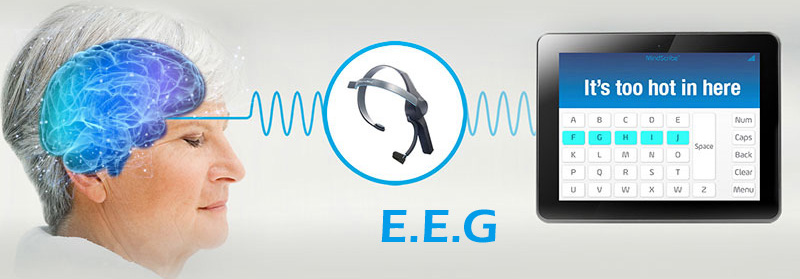
Brain cells communicate with each other by producing tiny electrical impulses. In an EEG, this faint electrical activity is measured by putting electrodes on the scalp. The test is performed by an EEG technician in your health care provider's office, at a hospital, or at a laboratory. You will be asked to lie on your back on a bed or in a reclining chair. The technician will place between 16 and 25 flat metal disks (electrodes) in different places on your scalp. The disks are held in place with a sticky paste. The electrodes are connected by wires to an amplifier and a recording machine. The recording machine converts the electrical impulses into patterns that can be seen on a computer screen and stored on a computer disk. Before computers, the activity was printed on paper. In either case, the electrical activity looks like a series of wavy lines. You will need to lie still with your eyes closed because any movement can change the results. You may be asked to do certain things during the recording, such as breathe fast and deeply for several minutes or look at a bright flashing light.
You will need to wash your hair the night before the test. Do not use any oils, sprays, or conditioner on your hair before this test. If you have a hair weave, you may want to ask the laboratory for special instructions. Your health care provider may want you to stop taking certain medications before the test. Do not change or stop taking medications without first talking to your health care provider. Bring a list of your medications with you. Avoid all foods containing caffeine for 8 hours before the test. Sometimes you may need to sleep during the test, so you may be asked to reduce your sleep time the night before. If you are asked to sleep as little as possible before the test, do not eat or drink any caffeine, energy drinks, or other products that help you stay awake.
EEG is used to help diagnose seizures and their type. It is also used to evaluate: Abnormal changes in body chemistry that affect the brain Brain diseases such as Alzheimer's disease Confusion Head injuries Infections Tumors.
Evaluate problems with sleep ( sleep disorders) Investigate periods of unconsciousness Monitor the brain during brain surgery An EEG may be done to show that the brain has no activity, in the case of someone who is in a deep coma. It can be helpful when trying to decide if someone is brain dead.
Abnormal results on an EEG test may be due to: Abnormal bleeding (hemorrhage) An abnormal structure in the brain (such as a brain tumor) Attention problems Tissue death due to a blockage in blood flow (cerebral infarction) Drug or alcohol abuse Head injury Migraines (in some cases) Seizure disorder (such as epilepsy or convulsions) Sleep disorder (such as narcolepsy) Swelling of the brain (encephalitis) Note: A normal EEG does not mean that a seizure did not occur.
© 2011 Shivam Diagnostics & Cancer Research Institute All Right Reseverd. Site Design & Developed By Shreeya Web Solutions